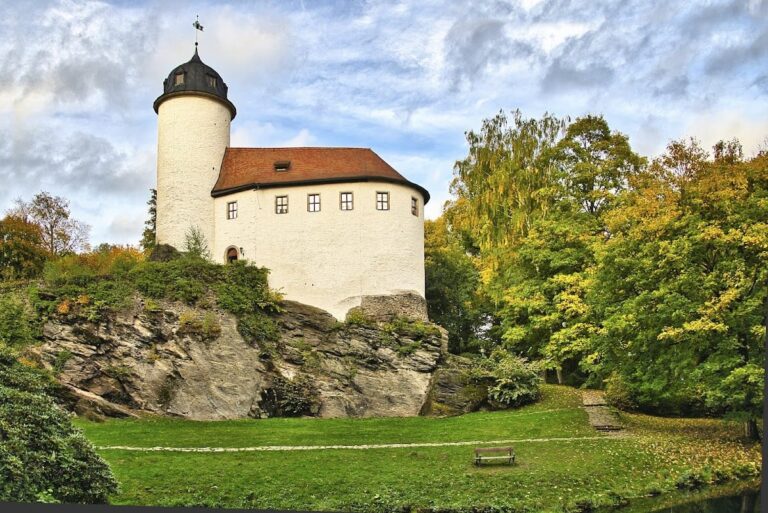Water Castle Klaffenbach: A Renaissance Water Castle in Chemnitz, Germany
Visitor Information
Google Rating: 4.6
Popularity: Medium
Google Maps: View on Google Maps
Official Website: www.c3-chemnitz.de
Country: Germany
Civilization: Unclassified
Remains: Military
History
Water Castle Klaffenbach is located in the municipality of Chemnitz, Germany. It was originally created during the Renaissance period by German builders skilled in castle construction.
The earliest phase of the castle’s history dates to the mid-16th century when Wolf Hünerkopf, an affluent mint master from Annaberg who had been ennobled in 1539 by Elector Johann Friedrich I, acquired the local lands in 1543. These territories once belonged to the Benedictine abbey of Chemnitz, which had been dissolved. Between 1546 and 1549, Hünerkopf constructed the castle in the Renaissance style, naming it Schloss Neukirchen. This building reflected his newly acquired noble status and wealth, marking a significant transformation of the estate.
By 1570, the site was recognized officially as a noble residence, known as “Sitz zu Neukirchen.” Around the turn of the 17th century, ownership changed hands when Dietrich von Taube, a nobleman escaping unrest in the Baltic region and who secured high-ranking roles at the Dresden court, took possession. Von Taube undertook notable expansions that embraced Renaissance architectural elements. It is believed he introduced distinctive features such as keel-arched roofs, elaborate gables, and a prominent main tower. The von Taube family maintained control of the estate for two centuries, until 1819.
That year marked a transition when Carl Heinrich Hähnel, a merchant from Schneeberg, purchased the property, ending the von Taube lineage of ownership. The estate remained in the hands of Hähnel’s descendants until 1909, after which it passed to Landesbank Berlin. In 1926, stewardship transferred to the local municipal authorities of Klaffenbach.
The castle’s function shifted considerably in the 20th century. Starting in 1935, it was utilized by the Reich Labour Service as a camp. Following the upheavals of World War II, Soviet military forces occupied the site. Later, during the period of the German Democratic Republic, the castle became a youth work home for girls aged 14 to 18 deemed challenging to educate according to the regime’s policies. This role continued until 1989.
After 1989, the building was in poor condition but underwent comprehensive restoration from 1991 to 1995. This work received funding and support from the European Union, the German federal government, and the Free State of Saxony. Since 1995, the castle has served as a cultural venue, organizing exhibitions, concerts, markets, and workshops. Ownership was formally assumed by the city of Chemnitz in 1997, reflecting its integration into the region’s cultural heritage.
Remains
Water Castle Klaffenbach stands as a four-story Renaissance water castle, characterized by its moat that encloses the main building and is crossed by a stone bridge providing access. Its roof design is particularly notable, featuring a rare cross-shaped configuration formed by two intersecting keel-arched gable roofs. This style echoes timber roof traditions of the 16th century. At each corner, diagonal gables add to the castle’s distinctive silhouette.
Inside, the ground floor houses several functional spaces, including an information center and event rooms. A key historical feature on this level is a small chapel featuring a ribbed vault, an architectural technique where intersecting ribs support the ceiling, accompanied by wall paintings dated to 1860. This chapel also serves as a site for weddings and contains a prominent relief carved in 1616 displaying the coat of arms of Dietrich von Taube. Originally positioned at the castle entrance, this relief has been preserved within the chapel.
The first floor, known as the “Green Salon,” serves as a combined conference and exhibition area. It retains portions of classical wall paintings that have either survived the centuries or have been carefully reconstructed. Above this, the second floor was an addition from the 17th century by Dietrich von Taube. It incorporates half-timbered walls, where wooden frames visibly outline panels filled with plaster or brick. This floor is decorated with ornamental ceiling designs and functions as exhibition space.
The uppermost story, once utilized as a storage attic, has been transformed into a citizens’ hall equipped with a small stage for performances. It notably exposes much of the original wooden beam construction, offering insight into traditional roof framing methods.
Surrounding the main castle are ancillary buildings arranged in a U-shaped courtyard. These structures accommodate various craft workshops, including a bobbin lace studio, a silversmith’s workshop, and a candle shop. Hospitality services such as a hotel and restaurants also occupy the complex. Between 1995 and 2008, the site hosted the Saxon Automobile Museum before the museum relocated to another historic venue in Chemnitz. Since then, the former museum space has been used by the Golfclub Chemnitz GmbH & Co. KG.
The grounds of Water Castle Klaffenbach have been recognized as a protected archaeological monument since 1969. This designation stems from the belief in an earlier fortress named Warta existing on the site. However, no archaeological evidence or historical documents have confirmed the presence of such a predecessor structure.










